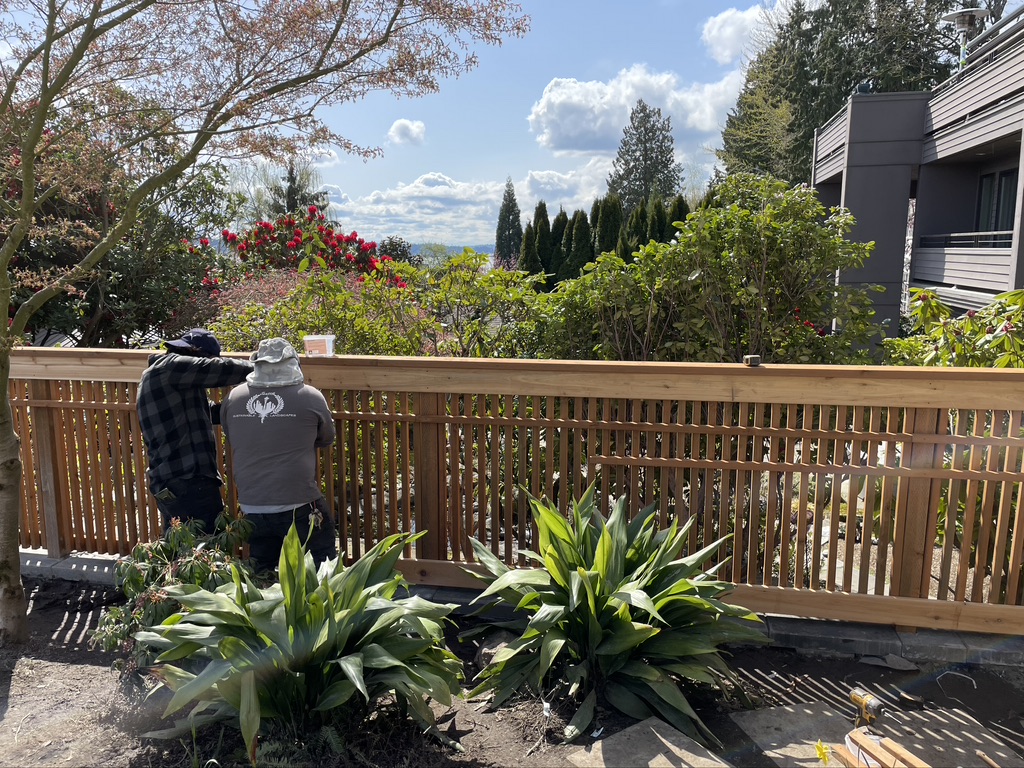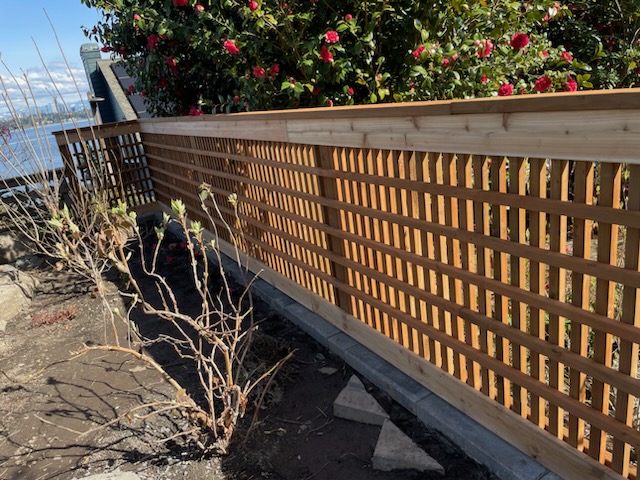Fences & Gates

Elevate Your Outdoor Space with Professional Fencing
We specialize in building and repairing fences for residential and commercial properties.
We pride ourselves on using eco-friendly materials and techniques to create durable and long-lasting fences and gates that blend seamlessly into their surroundings.
At Seattle Sustainable Landscapes our team of experienced professionals has the skill and knowledge to handle any fencing project, big or small.
Whether you need a new fence for added privacy, security, or aesthetics, we have the solutions you need. Let us help you enhance the look and functionality of your outdoor space with our sustainable fencing services.
The Role of Fences in Enhancing Your Property
The most common reasons for installing a new fence are:
- The existing fence is no longer serving its purpose – typically decaying and falling down.
- Privacy – typically people are looking for a space unencumbered by what is going on in the neighborhood.
- Containment – typically people are looking to contain pets or children inside the fenced area.
- Security – typically people are looking to keep people out of the fenced area, there may be valuables to protect, or the property is located in a dangerous part of the city.
Fence Options to Suit Your Style and Requirements
The type of fence is impacted by the reasons for the new fence. For instance, if containment is the only concern, then transparent and short fences are an option. Whereas, if privacy and security are factors then height and obscured materials are essential.
Fences can be a variety of materials – the four most common being metal, wood, stone, or a combination.
At Seattle Sustainable Landscapes our favorites are cedar fences either with cedar planks or Hog wire depending on how much privacy is desired.

Cedar Fences: A Popular and Long-Lasting Choice
Cedar is a popular choice for outdoor fencing due to its natural beauty, durability, and resistance to rot and decay. There is a reason roofs have been made from cedar all of these years! There are many different styles of cedar wood fences that can be used to enhance the appearance and functionality of your outdoor space. And they are made from cedar trees, a renewable resource.
Some common styles of cedar wood fences include:
- Solid privacy fence: A solid privacy fence is a tall fence with closely spaced slats or panels that provide complete privacy. This type of fence is often used to enclose a yard or garden or to create a sense of separation between properties.
- Vertical Picket Fence: this is the more traditional look.
- Horizontal Picket Fence: this is more of a modern aesthetic that uses slightly less wood.
- Picket fence: A picket fence is a shorter fence with spaced slats or pickets that create an open, decorative design. Picket fences are often used to define property lines or to add a decorative touch to a yard.
- Split rail fence: A split rail fence is a rustic-style fence with spaced horizontal or diagonal rails that are held in place by vertical posts. Split rail fences are often used in rural or natural settings, and are a popular choice for horse properties.
- Lattice fence: A lattice fence is a decorative fence with an open, criss-cross pattern created by interwoven slats or panels. Lattice fences can be used to add privacy or to create a visual barrier, while still allowing light and air to pass through.
- Shadow box fence: A shadow box fence is a semi-private fence with spaced slats or panels that are positioned on alternating sides of the fence. This allows air and light to pass through while still providing some privacy. Typically, shadow box fences are often used to define property lines and are selected because they look the same on both sides – there is no ‘pretty’ or ‘ugly’ side of the fence, contrary to most fences styles.
By considering these styles and their specific features, you can choose a cedar wood fence that best fits your needs and preferences.

Hog wire Fences: A Practical and Attractive Solution
Hog wire fences, also known as cattle panel fences or livestock panel fences, are traditionally associated with rural or agricultural settings. However, they can also be used in urban and suburban settings as decorative or functional fences.
Hog wire fences are made with a Cedar frame and thick wiring as the paneling (replacing the typical pickets). They can be used to create a modern rustic look and can provide a barrier while still allowing air and light to pass through. They can be used to enclose a yard or garden or to create a sense of separation between properties.
Hog wire fences can be used in urban and suburban settings as a way to contain pets or children, or to create a safe area for outdoor activities. They can be used to enclose a pool or spa or to create a playground or dog run.
When using hog wire fences in urban and suburban settings, it is important to consider local regulations and zoning laws, as well as any homeowners association guidelines that may apply. Some neighborhoods may have specific requirements for fence materials, height, or appearance.
Overall, hog wire fences can be a practical and durable fencing option as long as they are used in a way that is appropriate and compliant with local guidelines.
Choosing the Right Gate for Your Fence
When installing a wood gate to your fence, there are several factors that homeowners should consider to ensure the longevity and functionality of the gate. First and foremost, it’s important to choose a high-quality wood that is resistant to rot and decay, such as cedar or redwood. These types of wood are also naturally resistant to insects and pests, making them a great option for outdoor use. Additionally, homeowners should consider the design of the gate and how it will function with their existing fence. For example, a double-swinging gate will require more space than a single-swinging gate. Another important consideration is the hardware and hardware installation, a good quality hardware will help to keep the gate secure and ensure a smooth operation. Furthermore, proper staining or sealing the wood can help protect it from the elements and prolong its life. By taking these factors into account, homeowners can ensure that their wood gate will be a functional and beautiful addition to their fence for many years to come.
When it comes to wood gates, there are a variety of styles that are popular among homeowners. Some popular styles include:
- The classic wooden farm gate: This style of gate is often made of wood such as cedar or redwood and can feature either a single or double swing. It is a perfect choice for a rustic or country-style home.
- The arched wooden gate: This style of gate features a curved top and can add a touch of elegance and sophistication to any property.
- The wooden privacy gate: This style of gate is typically solid wood and is often used to provide privacy and security for a property.
- The wooden picket gate: This style of gate is characterized by its evenly spaced wooden pickets and is often used as an accent to a picket fence.
- The wooden lattice gate: This style of gate is characterized by its open lattice design and is a great option for homeowners looking for a gate that provides privacy while also allowing light and air to pass through.
Overall, the style of the gate will depend on the homeowner’s personal preference, the design of the existing fence and the purpose the gate will serve.
From Our Clients
“This has been my favorite home improvement project. This company literally made me a yard where there previously was overgrowth, concrete, large stumps and rocks. They were able to complete the project on time and their cost was much more reasonable than others I interviewed. The project lead Fernando was hard working and communicative. The owner David (and Jeff previously) as well as the GM Chris all stayed in touch throughout the project. I would definitely use them for other projects in the future”
“The team put in an irrigation system in our front and back yard, cleaned everything up and added many new plants to the sunny and shady areas around our home. The owner was very personable, explained everything well and did exactly what he said he was going to do. He was fantastic to work with. His team was wonderful, super hard workers, and very friendly. They helped create color and beauty in every nook and cranny of our yard. My husband and I are very thankful we used this company.”
“Happy with my choice. I had a very small townhouse backyard that was a bit of a mess (low quality builder-grade plantings) and had somewhat of an idea what to do with it. They provided good advice and the final result turned out very well. Finished ahead of schedule too! One year later and I'm still happy with the result. I definitely won't forget the attention and responsiveness of this company. Thanks a bunch! ”


